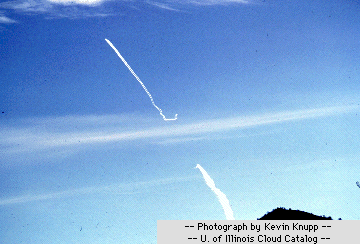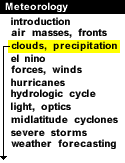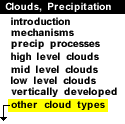
|
A contrail, also known as a condensation trail, is a cirrus-like trail of condensed vapor (often resembling the tail of a kite) that is produced by jet aircraft flying at high altitudes. Contrails are produced at altitudes high enough for water droplets to freeze in a matter of seconds before they evaporate. Temperatures at such altitudes are typically below -38 degrees Celsius.

Contrails form
through the injection of water vapor into the atmosphere by exhaust fumes from a
jet engine. If there is sufficient mixing between the cold upper tropospheric
air and the hot exhaust gases to produce a
state of saturation,
ice crystals will develop.
Even tiny nuclei
released in the exhaust fumes may be sufficient enough to generate ice
crystals.

|
Contrails spread apart and evaporate with time. If the air in which the cloud develops has a low relative humidity, the cloud particles will quickly evaporate. However, even in the presence of higher relative humidities, upper level winds can spread contrails apart, forming a horizontal sheet-like cloud. For a contrail to remain in tact for a long period of time, the air must have high a relative humidity and light winds. |
|




